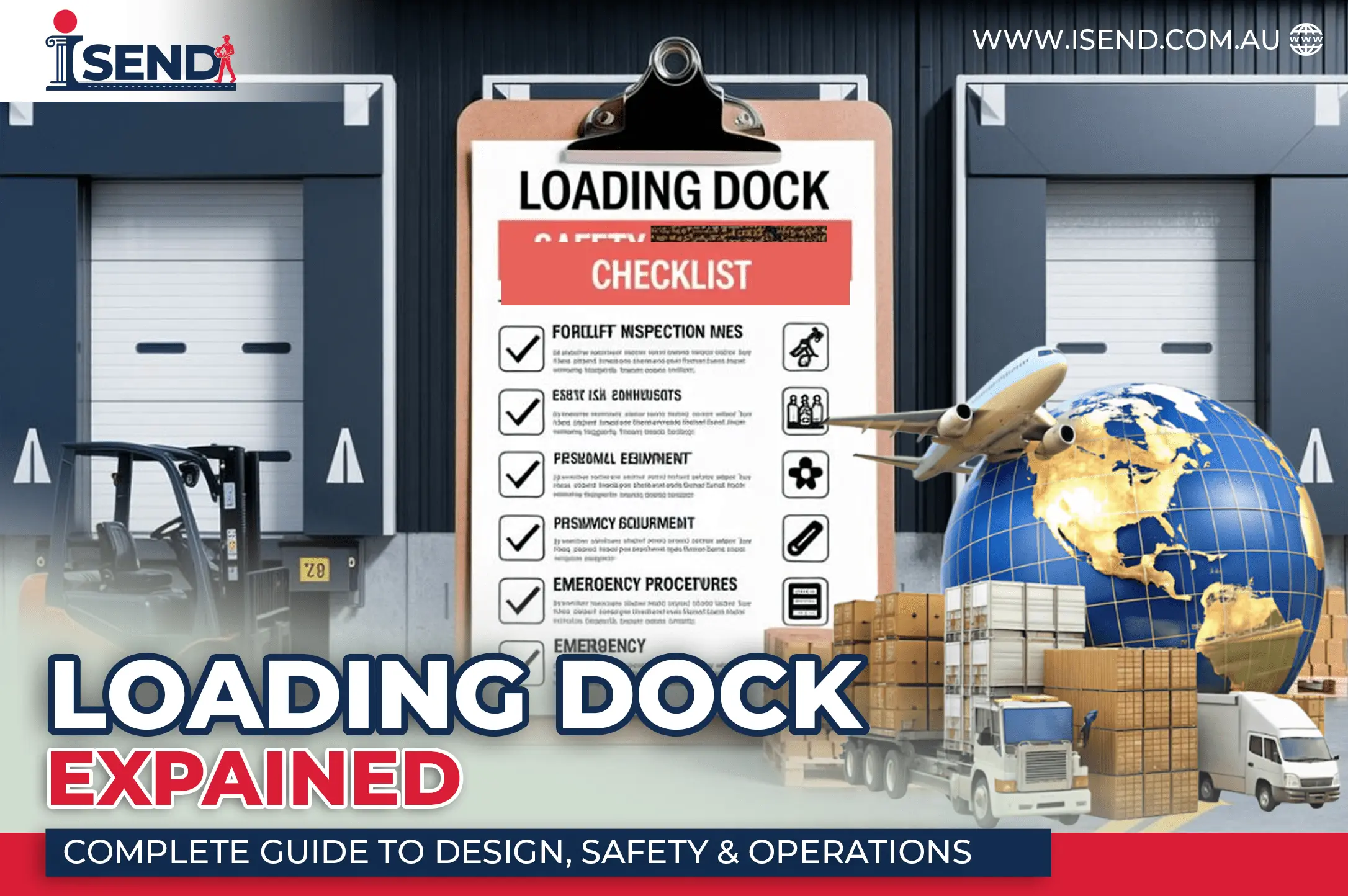You must have felt frustrated when the loading and unloading process of goods takes too long, especially if your business depends on the movement of goods. Logistics costs businesses billions annually in Australia.
The Bureau of Infrastructure and Transport Research Economics suggested that inefficiency could increase freight handling costs by at least 10%. Many of these difficulties are caused by improperly planned or unsafe loading dock procedures.
This guide contains all the information you need to know, including loading dock meaning, design and safety, Australian regulations, and trade tips.
What is a Loading Dock?
The definition of a loading dock is straightforward. It is a place within a warehouse, shopping centre, or logistics facility where goods are moved between vehicles and the building. A loading dock offers a safe and practical interchange point between forklifts, trolleys, and workers.
An example of how to handle large volumes of deliveries daily is in the areas of the Fed Square loading dock or the MCEC loading dock (Melbourne Convention and Exhibition Centre). Companies face delays, security risks, and increased expenses without organized docking zones.
If you are still wondering, what is a loading dock’s role in product delivery systems, keep reading till the end.
Australian Loading Dock Safety Regulations
Australia has strict laws governing occupational health and safety at work, including at the docks. The guidelines norms by Safe Work Australia demand that companies recognise and control risks such as falls, vehicle accidents, and hand-carrying injuries.
Key rules include:
- Distinct separation of vehicles
- Clear and Precise road signs for the drivers and pedestrians
- Safety barriers and dock restraints
- Utilising the latest technology for loading dock safety gears like dock levelers and PPE
Companies may be levied a fine of up to AUD 3 million for failing to meet these standards. This focuses on the importance of legal compliance in dock operations.
5 Key Components & Features of a Loading Dock
A loading dock is a well-designed system for parking trucks. With different features the loading lock ensures supply chain efficiency and safety. Each feature protects workers, speeds up handling, and keeps goods secure.
1. Elevated Platform
This platform raises goods to the trucks’ level. This reduces extra lifting equipment necessity and speeds up goods handling.
2. Dock Leveler
A dock leveler bridges the height difference between the dock and truck. This tool allows forklifts to move safely in and out of trailers.
3. Dock Doors
Strong, insulated doors protect goods and staff from weather conditions and secure the facility when not in use.
4. Building Integration
The dock should be an extension of the building plan. This will ensure effective workflows between warehouse storage, packing, and outbound work.
5. Essential Equipment
Most commonly used dock accessories include dock bumpers, wheel chocks, and lights and restraints. These enhance safety and avoid the destruction of both trucks and warehouses.
Purpose of Loading Dock in the Supply Chain
Dock loading is essential to logistics. It connects warehouses, trucks, and distribution networks. Without it, there would be stalling, increased expenses, and even safety threats to businesses. Modern e-commerce logistics in Australia relies heavily on efficient loading dock operations for last-mile delivery success.
Transition Point
The dock is the point of transition between vehicles and warehouses by which freight is transferred. It minimizes manual lifting and streamlines the supply chain.
Efficiency Benefits
A properly designed dock is time-saving. Loading dock ramps, for example, allow companies to deal with mixed delivery trucks immediately. Streamlined order fulfillment processes depend on properly designed loading dock facilities.
Business Impact
Sydney, Melbourne, and Brisbane companies understand that dock design affects profits. Shorter processing times result in reduced labour expenses and distribution delays.
Loading Dock Safety Considerations
A loading dock is a warehouse’s most hazardous and busiest area. The correct safety measures safeguard workers, minimize accidents, and create seamless operations of all Australian logistics facilities.
- Fall Hazards
Fall hazards refer to the possibility of falls among workers caused by elevated platforms. This requires the existence of guardrails, training, and compliance to prevent injuries and adherence to the national standards of warehouse safety.
- Separation of Vehicles
Forklifts, trucks, and pedestrians will likely have similar space. Clear paths and barriers reduce the chances of accidents and improve the safety of the entire loading dock of a busy assignment in the logistics industry.
- Heavy Machinery
Handling heavy machines like forklifts and pallet movers require professional training to avoid mishaps. Timely repair and maintenance of the machine, trained staff, and adherence to the rules of operating the machine reduces risks and minimises mechanical accidents chances.
- Environmental Conditions
Environmental conditions like rain, wind, and low-to-no-light conditions lead to slipping and poor visibility. To be on the safer side, using anti-slip mats, installing proper drainage systems, and weatherproofing is a must.
- Personal Protective Equipment (PPE)
PPE consists of high-visibility vests, helmets, gloves, and safety boots. Good quality PPE prevents injuries and complies with the safety rule for dock operations.
Safe docks prevent accidents, protect staff, and reduce insurance costs.
Types of Loading Dock Solutions
Choosing the right dock solution ensures efficiency and adaptability for different vehicles and business needs. Each system contributes to safe, cost-effective goods handling, from ramps to lift gates.
- Loading Dock Ramps
Loading dock ramps allow vehicles of different heights to access the dock safely. Portable ramps are often used for temporary facilities or seasonal demand.
Loading Dock Ramp Applications
A loading dock ramp can accommodate forklifts, pallet jacks, or trolleys. Businesses in high-volume centres like the MCEC loading dock rely on ramps to supply events efficiently.
Loading Dock Lift Gates
Curious about what a loading dock lift gate is and how it improves safety during loading operations? It is a mechanical platform attached to the back of a truck. It raises or lowers goods when a dock is unavailable. Lift gates are essential for smaller businesses or retail deliveries without access to a dock.
Dock facility planners often evaluate what is a loading dock lift gate’s impact on workflow speed.
Loading Dock Height
What is loading dock height and why is it important for warehouse design is a general query? In Australia, the standard height is usually around 1.2 metres to match semi-trailer floors. However,docks serving mixed fleets may require adjustable dock levelers to cater to different truck sizes.
How to Unload a Truck Without a Loading Dock
Most small or local companies do not have docks. Understanding alternatives aids in the continued movement of goods efficiently and safely, even without permanent facilities.
Mobile ramp usage: Mobile ramps enable forklifts and trolleys to unload directly off trucks and are adaptable to warehouses without permanent docks.
Use of lift gates in smaller deliveries: In retail or small business applications, the use of lift gates on the truck makes unloading easier, when the point of delivery can be a shop or a location without a loading dock. Heavy goods shipping relies on what is a loading dock lift gate for risk reduction?
Portable dock equipment rentals: Provisional equipment, such as hydraulic lifts and modular ramps, offers low-cost solutions to seasonal or pop-up facilities requiring reliable unloading and delivery.
Pallet jack and forklift use on flat ground: The operators can unload on a flat surface with no dock. However, operator safety should be considered to avoid tipping over and injuries.
Such solutions are widespread among local companies without integrated dock access.
Best Practices for Loading Dock Operations
Training, planning, and regular maintenance of the dock and equipment are essential for safe and efficient dock operations. Adherence to best operational practices minimises downtime and risks. Also, it ensures compliance with Australian workplace regulations.
- Educate employees about dock use:
- All employees must be trained on appropriate use. This will ensure that every employee understands how to use the equipment at the dock and adheres to the safety rules.
- Maintain clear dock areas
Cluttered dock areas can cause people to fall over and slow down forklifts and people during peak operations.
- Check loading dock ramps and levelers
A regular check ensures that ramps and levelers are in good condition, preventing expensive failures or injuries when freight is being loaded in large quantities.
- Barriers and wheel chocks
Using these can stop vehicle movement and prevent vehicles from rolling over workers and equipment during loading and unloading.
- Use visible signage to define pedestrians and forklifts
Visible signs and lanes enhance safety by guiding workers and forklifts to designated routes.
- Check the adherence to loading dock safety regulations weekly
Routine inspections can help ensure that the rules are observed and that safety systems are maintained in their effectiveness.
Such facilities from the Fed Square loading dock offer good examples by imposing rigid time schedules, equipment inspections, and driver regulations.
The loading dock is more than a place for trucks to park. It is the heartbeat of logistics operations.
Conclusion
The loading dock meaning goes beyond a place for trucks to park. It is the heartbeat of logistics operations. From the Fed Square loading dock to regional centres, Australian businesses rely on safe, efficient docks to stay competitive.
Following loading dock safety norms is mandatory. Investing in cutting-edge equipment like loading dock ramps, and knowing how to unload a truck without a loading dock reduce risks and increase efficiency. Whether working with a significant event hub like the MCEC loading dock or running a small warehouse, understanding what is a loading dock, loading dock lift gate and loading dock height helps plan smartly. Many businesses partner with 3PL logistics providers to optimize their loading dock and distribution operations.
A safe and well-designed dock is not just an asset but a necessity for Australian supply chains.





